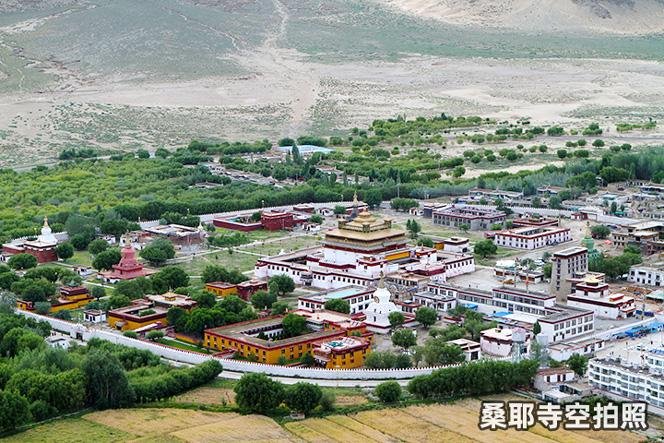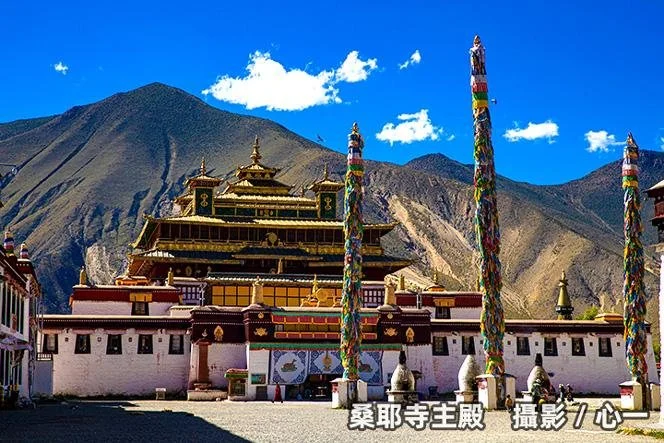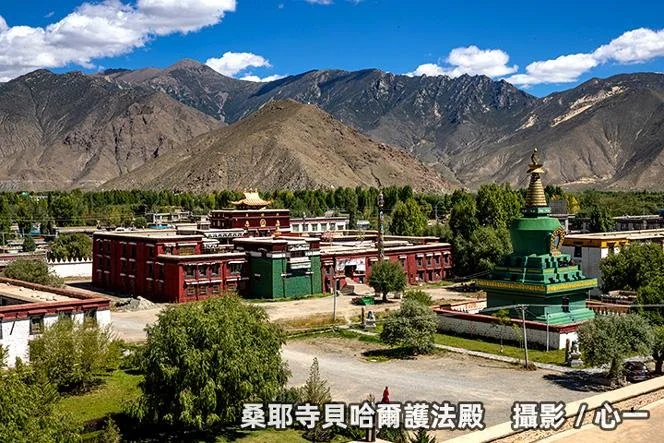Lecture No. 0287
Great Ocean of Lamrim
Lecture No. 0287
Lamrim Volume 1 : P37LL10 ~ P38-L3
Tape No: NA
Date: 15 Jun 2022
Topic: Commentator Santaraksita’s brief biography, and entering Tibet to build Samye Monastery
When Khenpo Santaraksita arrived in Tibet, he began the construction of the Samye Monastery, which was modeled after Otantapuri Monastery. Rinpoche added, the Eight Outlying Temples around the Chengde Mountain Resort, near Beijing City, China, was built this way, designed after the four main continents and eight sub-continents. Some monasteries in Chengde were also bulit following the architectural design of Samye Monastery. In addition, the monastery on the mountain top of Beijing’s Summer Palace were also built according to the design of Samye Monastery. [00:29]
The Samye Monastery mentioned here (in the text) was built after Master Santaraksita arrived in Tibet. So, let me introduce Master Santaraksita first! Commentator Santaraksita was the founder of the Yogācāra-Svātantrika-Mādhyamaka Sect. He was also known as the Great Preceptor Bodhisattva. Do you know where commentator Santaraksita was from? He was born in Bangladesh, around 725 to 788 CE. At a young age, he was ordained by his teacher, Jñānagarbha, and began to follow this virtuous teacher to study the scriptures. Later he relied on his gura Acharya Vdul-bavi-sde and under Vdul-bavi-sde’s guidance, Master Santaraksita received the teaching of the Ornament for the Clear Knowledge. Since he recognized that Profound View and Extensive Deeds are equally important, Master Santaraksita furthered his studies on the wisdom of emptiness passed down from Nagarjuna Bodhisattva. Master Santaraksita composed the Ornament of the Middle Way. [01:39]
During the 8th century, Master Santaraksita entered Tibet on the invitation of the Tibetan King Trisong Detsen. Then Samye Monastery was constructed. He then ordained the very first seven Tibetan monastics there. The 8th century is about 1,200 years from now, they were the first to be ordained in Tibet, right? That took place at the Samye Monastery. After the ordination of the seven monks, Master Santaraksita began to establish the monastic education system, teaching vinaya and Madhyamaka. Since then, he stayed in Tibet until he passed away. His primary disciples were the commentators Haribhadra and Kamalasila, both of whom were very prominent! [02:28]
Thus, Samye Monastery, due to King Trisong Detsen, Guru Padmasambhava, and Commentator Santaraksita’s influence integrated the three architectural styles of the Chinese, Tibetan, and Indian, into its construction. After the Monastery was completed, it was burned down a few times but was restored each time. Later [in the 9th century], there was a Tibetan king who suppressed and destroyed Buddhism. In the 11th century, those monastics that fled into exile with no place to live returned to Tibet and gathered at Samye Monastery. Gradually, Samye Monastery became the Dharma center of the Nyingma School. So this Samye Monastery was modeled after the four major continents of the Otantapuri Monastery. This is a legend in regard to the Otantapuri. [03:24]
[*color scheme of annotations green: Master Nga-wang Rab-ten/Venerable Yu]
Then it is mentioned here on the finest variations [of monastic discipline between different schools] – such as how to receive food, Master Atisha studied them meticulously; that is, instead of studying them cursorily, he studied carefully. He thereby was praised as: he grasped the gist of the scriptural knowledge of all sublime teachings flawlessly. Take heed! Being able to comprehend the essence of the sublime scriptural knowledge is in itself a remarkable feat, whereas he came to know accurately all the key points of the scriptural teaching [Lamrim vol. 1 p.38 L1]. [05:03]
【广海明月 讲次: 0287】
讲次 | 0287
标题 | 静命论师略传、入藏建桑耶寺
《广论》段落 | P4-L2 ~ P4-L4 此后乃至三十一岁……正法中枢要处者。
入门段落 | 第1册 P111-L7 ~ P111-LL1 静命大堪布到西藏......一切教正法的扼要
备注 | 四家合注《白话校注集》第1册 P121-L10注释⑦ ~ P121-LL5注释⑧完 桑耶寺......莲花戒论师等
(更新日期: 2022年6月15日)
00:00
静命大堪布到西藏的时候,他最初创建了桑耶寺,也是仿造能飞聚落这座寺院建的。仁波切还讲:在中国北京承德的外八庙也是这样盖的,仿造四大洲、八小洲。承德有些寺院也是仿造桑耶寺的建筑,还有北京颐和园山顶上的寺院,也是仿桑耶寺盖的。00:29
那么这里提到这个桑耶寺,是静命大师来到西藏的时候建的。那么我先讲一下静命大师吧!静命论师,他是瑜伽行中观自续派的开派祖师,他又有一个名字是大亲教师菩提萨埵。大家知道静命论师是哪儿的人吗?他出生在孟加拉,约公元 725 年到 788 年。年少的时候,在他的亲教师智藏的座前出家,并且依止这位善知识开始研习律典,之后又依止调伏军阿阇黎听受了《现观庄严论》。由于观察到深见、广行不可偏废,所以进一步精研龙树菩萨所传的空性教授,他的著作就是《中观庄严论》。01:39
然后在 8 世纪的时候,他应藏王赤松德赞祈请就进入了西藏,然后修建了桑耶寺。最初就度了七个人在桑耶寺出家。8 世纪的时候,距今大概 1200 年左右,这是西藏最早的出家人,对吧?在桑耶寺。七个人出家之后,开始建立僧伽制度,宣说了戒律、中观。从那个时候开始,他就一直住在西藏直到示寂。他的主要的弟子是狮子贤论师、莲花戒论师,都是非常非常著名的!02:28
那么桑耶寺,就是由赤松德赞王、莲花生大师还有静命论师三个人融合了汉、藏、印的三种建筑风格而成的。在建成之后,几度被焚毁,但是又都修建成了。后来藏区有一个灭法的王出现破坏佛法,11 世纪的时候,原来跑到各处流亡、没有地方住的僧众就返回了西藏,聚集在桑耶寺,其后就逐渐成为了宁玛派的道场。所以这个桑耶寺,它就是仿照能飞聚落的那个四大洲建立的。这是关于“能飞聚落”的一个说法。03:24
然后在这里边说到最细小的差别处、微细分——比如说比丘怎么受食——这些都学得非常精细,他不是粗略地学,是非常精细地学。所以才赞美他说:无倒地通达了一切教正法的扼要。注意哦!这个通达教正法的扼要,就已经是了不得的一件事,他是无倒地通达了一切教正法的扼要。05:03



